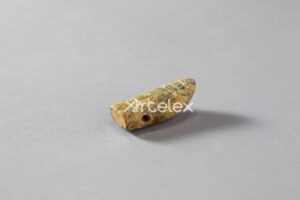This sculpture depicts the larva of a cicada, rendered in moss green jade with patches of brown and yellow. The life-sized piece represents a large cicada larva, commonly known as the “chirping” cicada, which would have been found in the soil. The sculpture features two antennae and subtle delineations on both sides of the neck. Three horizontal lines are engraved on the top and bottom, and the abdomen is shaped like a sausage. A biconical hole pierces the thorax, likely for attachment purposes. Cicada larvae typically live underground for five to six years, feeding on roots, or above ground for three years, surviving on fruit nectar. After this period, they mature into adult cicadas. In ancient times, the cicada symbolized the pursuit of noble integrity and longevity. It was revered by the ancients for its successful, cyclical life pattern. Comparable examples can be found in the Aurora Museum.
한국어

